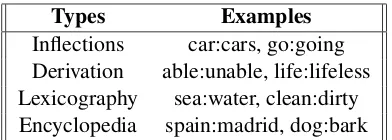Using Graphs for Word Embedding with Enhanced Semantic Relations
10
0
0
Full text
Figure




Related documents
The overlap-based algorithms stem from the Lesk (1986) one, which inspired a whole family of meth- ods that exploit the number of common words in two sense definitions ( glosses )
For in- stance, in unsupervised WSD a number of methods (Widdows and Dorow, 2002; V´eronis, 2004; Agirre et al., 2006) have constructed word co-occurrence graphs for a target
C: cipher text, which is an encrypted secret message using AES algorithm and streamed as 3-bit words, k: constant value to signify the embedded pixels.. T: number of left
In almost cases of applying machine learning algorithms to text mining texts, texts or words are encoded into numerical vectors.. In order to solve the problems in encoding